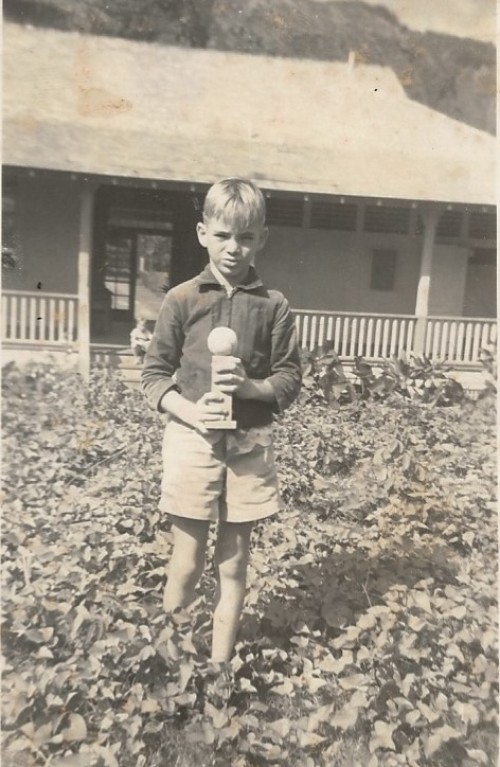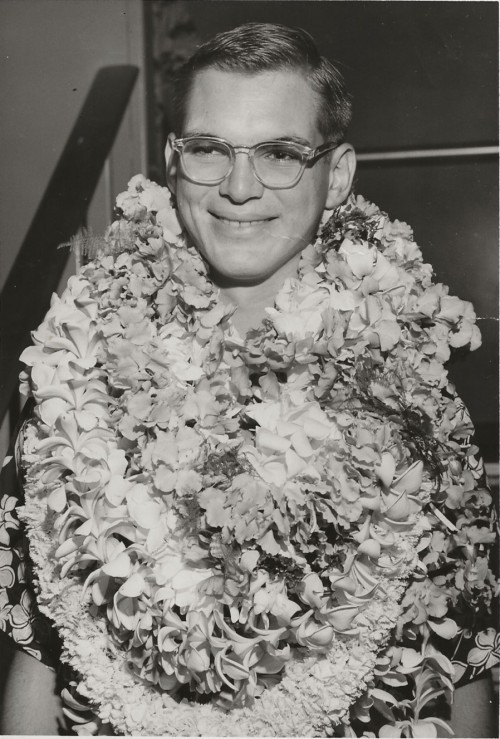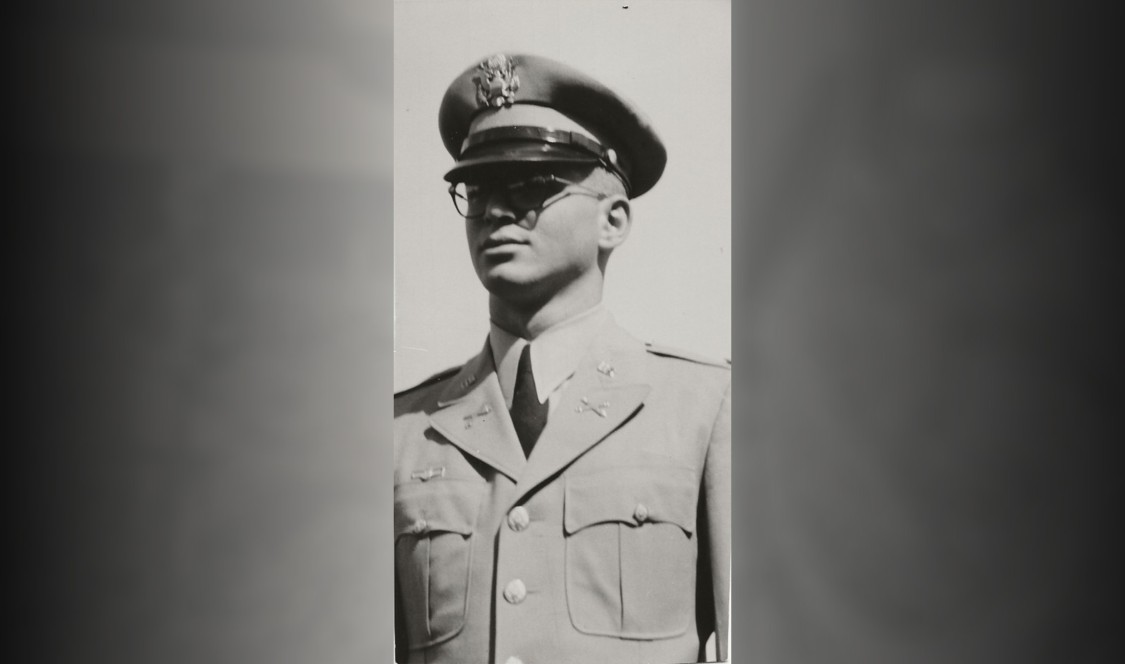John Devereux ’57, was born and raised on Oahu and still vividly remembers standing on the front porch of his home in Manoa Valley at 5 years old, when he saw clouds of black smoke rising over Pearl Harbor on December 7, 1941. Suddenly a large shell came zooming toward him over nearby Tantalus Mountain and exploded on the mountain side where John liked to play. John was not sure what was happening, but he had the feeling things were about to change in the peaceful life he and his family enjoyed living in Hawaii. The war in the Pacific had begun!
John Devereux’s father, John Wm. Devereux, M. D., was a General Practitioner and his mother, Dorothy Devereux, was a Registered Nurse. Soon after learning of the bombing, they were among the first civilian medical teams rushing into Pearl Harbor to help where they could. They received a letter permitting them to pass through the gates into Pearl Harbor. John’s father also oversaw medical stations on Oahu that treated severely wounded civilians, soldiers, and sailors. John’s mother, aghast at the devastation and carnage, relocated to the Queen’s Hospital Blood Bank, a facility the couple had been instrumental in creating before the war. John, his younger brother, and sister remained home with their caregiver.

Family life changed dramatically. They dug a bomb shelter under the house. During air raids they filled their one bathtub with water for fear the Japanese might poison the water supply. They installed blackout curtains on the windows, carried gas masks, planted and tended Victory Gardens, and put black tape over the headlights of their car so only slits of light would show. Air raid sirens screamed, and search lights flooded scary nights until the “all clear” was given once false alarms were confirmed. Sailors and soldiers often stayed in their home, and soldiers pitched tents near their property. Fear of a second attack was always on their minds.
John went to the non-English Standard Manoa School next to his home and at age 5, was the first “Haole” (white person) to attend the school. As John grew, he discovered his natural sales ability and won first prize in third grade for selling the most war bonds door-to-door. His prize? A baseball autographed by William R. Furlong, U.S. Rear Admiral who served as Chief of Naval Ordnance in Hawaii, tasked with the responsibility of salvaging and repairing of the sunken U.S. ships at Pearl Harbor. Unfortunately, the ball was used to play catch by his son and cousin, and the autograph was lost...but John still has it displayed on his shelf!
One of John’s friends was his CMC Classmate Stuart Ho ’57, and their friendship began when they entered 7th grade at Punahou School. They joined the high school ROTC program in the 9th grade. John excelled in high school. He was Vice President of his student body in his senior year, an all-star football player, and Battalion Commander of his high school ROTC Cadet Corps. He was not terribly interested in going to college but finally applied. John was accepted by 6 schools, but Claremont Men’s College was the only one that did so “on a probationary basis.” This annoyed John and is one of the reasons he chose to attend CMC - to prove he had the smarts to attend and succeed. His conclusion was that “he made an excellent decision.”
Coming to CMC was an ordeal. Having never been off the Hawaiian Islands, John came to California by ship. Then followed a train trip to San Lus Obispo where he stayed with his grandparents and then on to Paso Robles to visit his aunt and uncle. Helping his uncle, John hooked up long lengths of irrigation pipes and loaded hay into a truck. A full day’s work was accomplished by noon leaving him bruised and bloody, but John was never afraid of demanding work.
John was finally dropped off at CMC by another uncle. In 1953, the small student body consisted of 276 students, 25 faculty, and 7 Military Science Cadets. It was composed of recent high school grads who lived in Story House and the four original dorms, married veterans on the GI Bill lived in barracks-like arrangements near where the Athenaeum stands today, and bachelor veterans also on the GI Bill lived in the basement of Bridges Hall Auditorium, referred to as “Coconut Gove. Freshman hazing followed where new students were forced to undergo foolish activities.
John’s father and mother enjoyed the hobby of raising thousands of orchid plants on their property in Hawaii and would send John corsages he sold to other students for dances. John’s mother was a very accomplished woman and in addition to being a nurse, she raised three boys and a girl, while tending award winning orchids. Dorothy Devereux became one of the first female Assemblywomen in the Territorial and State Legislatures for Hawaii serving for fourteen years and all the while actively helping others.
In addition to enjoying a robust social life, John applied himself on the Pomona-Claremont Football Team. He was an aggressive competitor and a hard nose linebacker who called defensive signals. His specialty was a forearm smash called a “Rip Up” that invariably knocked his opponent backward. Playing on both offense and defense for 4 years, his coaches found that John, although playing end, was extremely accurate in snapping the ball and became a single wing center - never missing his target. The team was very successful, and John won all-Conference and West Coast Small College honors. He was also recognized as CMC Co-athlete of the Year and is in the CMC Sports Hall of Fame. Jack Kemp who played Quarterback for Occidental College for 4 seasons against the Pomona-Claremont team and went on to play professional football commented during a talk at the LA Athletic Club, that “the Pomona-Claremont team was one of the toughest he’d ever played against.”

Even with all these activities, John was able to achieve a mostly B grade point average. He was a business administration major but found Spanish to be extremely challenging. He passed his final exam by drawing a picture of a cowboy on a horse and labeling the various parts in Spanish. His professor, Bertha Ward, was so impressed with John’s creativity that she passed him. John gives high praise to CMC founding President Dr. George C.S. Benson, who retired with the rank of Lieutenant Colonel and was very active in the founding and growth of the College and the University ROTC program nationally. John was impressed with Dr. Benson because of his kindness and understanding, while always making himself available to students and treating them like men.
Because of his participation in high school ROTC, John jumped ahead a year in the program. He excelled at summer camp at Ft. Lewis, Washington and was honored at graduation as a Distinguished Military Graduate. His branch choice was Artillery.
After returning to Hawaii and a job at Gaspro, an industrial supply company, John moved on to life as a Second Lieutenant assigned to a Nike Missile Battery at Ft. Bliss, Texas. He was assigned as the supply and sports officer. Football was in his blood, and he joined the Army Football Team as a lineman. He found that his football skills were better than some of the players from large colleges. John’s life suddenly changed again when health complications required x-rays to be taken, the Army discovered for the first time that he was born with only one kidney. He was immediately medically discharged in 1958 “after serving 8 months, 8 days, and 8 hours.” He told his Commanding Officer he wanted to stay in, but regulations were regulations, and the Army would not allow anyone to serve with only one kidney.
Returning to Oahu, John continued working for Gaspro; then moved on to the Whittaker Corporation in Los Angeles in the contracts division. In 1960 he joined Coldwell Banker in the real estate property management department. He excelled at his sales job and in 1962 was relocated to Phoenix where he managed its property management department. He became President of the local Building Owners and Managers Association. He was elected to the Board of Young Republications and organized a Luau celebration for Barry Goldwater with about 600 guests complete with roasted suckling pigs and leis! After two years he returned to Los Angeles in Coldwell Banker’s commercial sales and leasing department until 1972, when he started the John Devereux Company based in San Marino. John took evening classes at Claremont Graduate School and earned his MBA degree in 1976, including five with Peter Drucker.
John enjoyed remarkable success in the commercial real estate field. His specialty was restaurant transactions, and he logged more than 170 successful deals including 13 McDonalds. John married Dori Devereux in 1960, and they had three children. Divorced years later, John married his second wife, Norva Lee, in 1978 after meeting her on a blind date. They lived in Pasadena, then moved to Roseburg, Oregon to be with Lee’s parents. The couple relocated to Newport Beach in 2014, to be near their daughter and her family - where they now enjoy retirement.
Continuing in his real estate business, John and Lee purchased “Flowers of Hawaii,” allowing them to share their Aloha spirit with others. They provide Leis for CMC class reunions and other special events. This included John arranging transportation and Lei greetings for his CMC friend, Thorton Hamlin ‘50 and his family, when Thornton made a visit to Pearl Harbor. Thornton wanted to return the American Flag to the USS Parche (SS-384) Submarine, whose conning towner is on display at the USS Bowfin Submarine Museum. Thornton told John he had “borrowed the flag” after serving on the Parche during four of six combat patrols in the Pacific during WWII. The extraordinarily successful Parche won five battle stars and a Presidential Citation for action in the Pacific Theater.
John offers the following life lessons learned from his exceptional parents, siblings, and family background living in Hawaii with multiple ethnic backgrounds, attending Manoa and Punahou Schools, his military service, and much more:
- Can’t - there is no such word in his vocabulary.
- Never Quit – always be a leader.
- Help Others – find ways to give of yourself.
- Have a positive attitude – don't let anything stop you from accomplishing your goals.
- Practice the Aloha Spirit – learn to always enjoy, get along with others and be respectful.
Here are a few of John’s impressive credentials:
- Graduate of CMC Class of 1957, Distinguished Military Graduate
- Vice President of Class of 1957, classmates say he is “the glue that keeps us together”
- Member of the Board of Directors of the CMC Alumni Association
- MBA from Claremont Graduate School in 1976
- Founding President of Southern California Chapter of Punahou Alumni Association
- Board of Directors of the Pasadena and San Marino Chambers of Commerce
- Chair of the San Marino Community Chest
- Board of Directors of the Polynesian Society of Los Angeles

